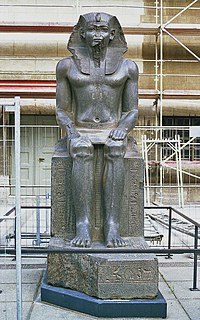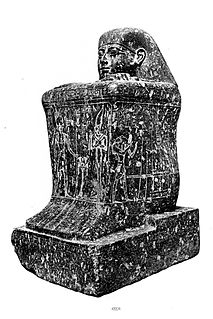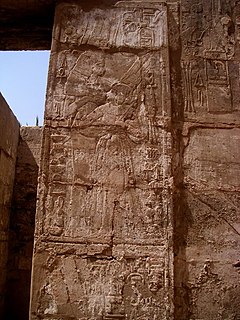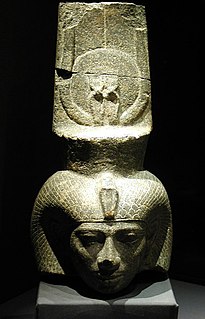
Sobekneferu reigned as pharaoh of Egypt after the death of her brother Amenemhat IV. She was the last ruler of the Twelfth Dynasty of Egypt and governed Egypt for almost four years from 1806 to 1802 BC. Her name means "the beauty of Sobek."

Amenemhat IV was the seventh and penultimate pharaoh of the 12th Dynasty of Egypt during the late Middle Kingdom period, ruling for over nine years in the late 19th century BC or the early 18th century BC.

Nubkaure Amenemhat II was the third pharaoh of the 12th Dynasty of Ancient Egypt. Although he ruled for at least 35 years, his reign is rather obscure, as well as his family relationships.

Amenirdis I was a God's Wife of Amun during the 25th Dynasty of ancient Egypt. Originating from the Kingdom of Kush, she was the daughter of Pharaoh Kashta and Queen Pebatjma, and was later adopted by Shepenupet I. She went on to rule as high priestess, and has been shown in several artefacts from the period.

Shoshenq VI is known to be Pedubast I's immediate successor at Thebes based upon the career of the Letter Writer to Pharaoh Hor IX, who served under Osorkon II and Pedubast I. Since Shoshenq VI's prenomen is inscribed on Hor IX's funerary cones, this indicates that Hor IX outlived Pedubast I and made his funeral arrangements under Shoshenq VI instead. His prenomen or royal name was "Usermaatre Meryamun Shoshenq" which is unusual because it is the only known example where the epithet "Meryamun" appears within a king's cartouche. Shoshenq VI's High Priest of Amun was a certain Takelot who first appears in office in Year 23 of Pedubast I.

Hor Awibre was an Egyptian pharaoh of the 13th Dynasty reigning from c. 1777 BC until 1775 BC or for a few months, c. 1760 BC or c. 1732 BC, during the Second Intermediate Period. Hor is known primarily thanks to his nearly intact tomb discovered in 1894 and the rare life-size wooden statue of the king's Ka it housed.

Shepenupet I or Shapenewpet I was God's Wife of Amun during the Twenty-third Dynasty of Egypt.

Ankhnesneferibre was an ancient Egyptian princess and priestess during the 26th Dynasty, daughter of pharaoh Psamtik II and his queen Takhuit. She held the positions of Divine Adoratrice of Amun and later God's Wife of Amun between 595 and 525 BC, during the reigns of Psamtik II, Apries, Amasis II and Psamtik III, until the Achaemenid conquest of Egypt.

Shepenupet II was an Ancient Egyptian princess of the 25th Dynasty who served as the high priestess, the Divine Adoratrice of Amun, from around 700 BC to 650 BC. She was the daughter of the first Kushite pharaoh Piye and sister of Piye's successors, Shabaka and Taharqa.

Seankhibre Ameny Antef Amenemhet VI was an Egyptian pharaoh of the early Thirteenth Dynasty ruling in the first half of the 18th century BC during a time referred to as the late Middle Kingdom or early Second Intermediate Period, depending on the scholar. Amenemhat VI certainly enjoyed a short reign, estimated at 3 years or shorter. He is attested by a few contemporary artefacts and is listed on two different king lists. He may belong to a larger family of pharaohs including Amenemhat V, Ameny Qemau, Hotepibre Qemau Siharnedjheritef and Iufni.

Sanatruq II was the last king of Hatra, ruling from about AD 200 to 240/41. He was the son of king Abdsamiya and is attested by nine inscriptions discovered at Hatra. Only two of these inscription bear year datings, both are hard to read.(perhaps 231 and 237/38) Sanatruq II appears in Syrian sources as Sanatru and in Arab sources as Daizian and Satirun. One of his inscriptions was found on a statue showing him standing. His wife was perhaps Abbu. There are two sons known. Abdsamiya was named after his grandfather. He was his heir. Another son, Mana is attested in year 235 and seems to had Arabia of Wal under his control. This is a region southeast of Edessa. From the latter evidence it seems that Sanatruq II expanded his territory. The daughter Duspari is known from a statue, dated to year 549. As second statue belongs to her daughter Samay.
Abdsamiya was a king of Hatra, an ancient city and kingdom in ancient Mesopotamia (Iraq). He reigned from about AD 180 to 205. Abdsamiya was the son of king Sanatruq I and the father of Sanatruq II. Abdsamiya is known from eight inscriptions found at Hatra. One of them reports the building of a porticus for the king and is dated to year 504 of the Seleucid era. Another inscription appears on a statue and is dated to AD 201/202. Abdsamiya is most likely also mentioned by Herodian (3.1.3). There he appears as Barsemias. He supported in year AD 192 Pescennius Niger against Septimius Severus.
Iufni was an Ancient Egyptian pharaoh of the 13th Dynasty during the Second Intermediate Period. According to the egyptologists Kim Ryholt and Darrell Baker he was the 7th king of the dynasty, while Jürgen von Beckerath and Detlef Franke see him as the 6th ruler. Iufni reigned from Memphis for a very short time c. 1788 BC or 1741 BC.

The Southern Mazghuna Pyramid is an ancient Egyptian royal tomb which was built during the 12th or the 13th Dynasty in Mazghuna, 5 km south of Dahshur, Egypt. The building was never finished, and is still unknown which pharaoh was the owner, since no appropriate inscription have been found.
The pyramid was rediscovered in 1910 by Ernest Mackay and excavated in the following year by Flinders Petrie.

The Northern Mazghuna Pyramid is an ancient Egyptian royal tomb which was built during the 12th or 13th Dynasty in Mazghuna, 5 km south of Dahshur. The building remained unfinished, and it is still unknown which pharaoh was really intended to be buried here since no appropriate inscription has been found.
The pyramid was rediscovered in 1910 by Ernest Mackay and excavated in the following year by Flinders Petrie.

The Bust of Amenemhat V is a sculpture showing the head of the Ancient Egyptian king Amenemhat V, who ruled at the beginning of the Thirteenth Dynasty. One of the major art works of this period, it is today in the Kunsthistorisches Museum in Vienna with the inventory number ÄS 37.

The Statue of Sobekneferu was a sculpture of the Ancient Egyptian queen Sobekneferu, who reigned during the 12th dynasty.

Sarenput II, also called Nubkaurenakht was an ancient Egyptian nomarch during the reign of pharaohs Senusret II and Senusret III of the 12th Dynasty.

Khenmet was an Ancient Egyptian king's daughter of the Twelfth Dynasty, around 1800 BC. She is mainly known from her unrobbed tomb containing a set of outstanding personal adornments.
Sebat was an Ancient Egyptian king's daughter of the Twelfth Dynasty. Her only known title is king's daughter of his body. She is so far only attested on the back slab of a statue base found at Serabit el-Khadim on Sinai. The statues are now lost but once depicted a falcon, king Amenemhat I and king Senusret I. The inscription mentions at the top Amenemhat II and in a lower register Senusret I, the king's daughter Sebat, the king's wife Neferu, Amenemhat I and again Senusret I. From this evidence it seems clear that Sebat was the daughter of Senusret I and Neferu and the sister of Amenemhat II.



















